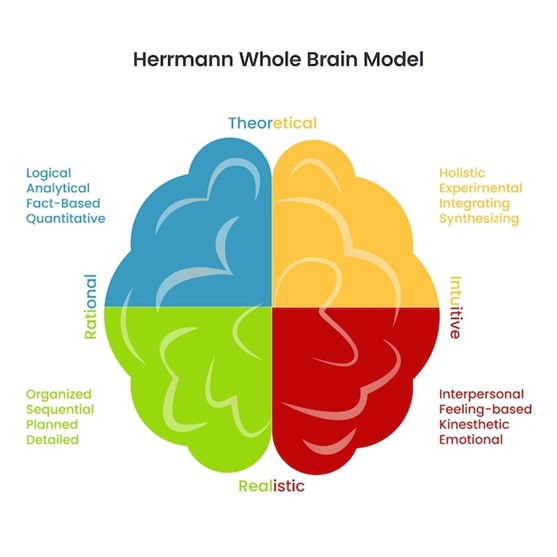The Herrmann Brain Dominance Instrument (HBDI) is a powerful tool that helps individuals understand their thinking preferences and cognitive styles. Developed by Ned Herrmann, this model categorizes thinking into four preferences: Analytical, Practical, Relational, and Experimental. Each preference represents a different way of processing information and making decisions. By understanding these preferences, educators and trainers can tailor their instruction to better meet the needs of learners and enhance their comprehension and content retention. The impact of HBDI thinking preferences extends beyond the classroom and into the workplace. By understanding the HBDI thinking preferences of employees, organizations can design WHS learning and development programs that meet their unique WHS training needs in Sydney, Melbourne, Brisbane, Perth, Adelaide and across Australia.
The Four Thinking Preferences of the HBDI Model
The HBDI model identifies four distinct thinking preferences. The Analytical preference is characterized by a logical and systematic approach to problem-solving. Individuals with this preference excel at analyzing data, conducting research, and making data-driven decisions. The Practical preference focuses on practical applications and hands-on experiences. These individuals learn best through real-world examples and prefer to learn by doing. The Relational preference emphasizes interpersonal connections and collaboration. Learners with this preference thrive in group discussions, teamwork, and building relationships. The Experimental preference embraces creativity and innovation. These individuals prefer to explore new ideas, take risks, and think outside the box.
Understanding Cognitive Styles and Their Impact on Learning
Cognitive styles refer to the unique ways individuals process information and learn. Different cognitive styles can significantly impact the learning experience, comprehension, and content retention. Individuals with an Analytical cognitive style tend to prefer structured and organized learning environments. They thrive on clear instructions and logical sequencing of information. Practical learners, on the other hand, prefer hands-on activities and real-world applications. They learn best when they can immediately apply what they have learned. Relational learners thrive in collaborative environments that allow for discussion, group work, and building relationships. Experimental learners, with their creative and innovative nature, excel in open-ended and flexible learning environments that encourage exploration and experimentation.
The Relationship between HBDI Thinking Preferences and Comprehension
The HBDI thinking preferences play a crucial role in learners’ comprehension. When instruction is aligned with individuals’ thinking preferences, they can better engage with the content and make connections to their existing knowledge and experiences. For example, an Analytical learner will benefit from clear and structured presentations with ample opportunities for analysis and problem-solving. Practical learners will grasp concepts more effectively when presented with real-life scenarios and hands-on activities. Relational learners thrive in collaborative learning environments that foster discussions and encourage the exchange of ideas. Experimental learners, with their natural curiosity and desire for innovation, excel when provided with opportunities for exploration and creativity.
How HBDI Thinking Preferences Influence Content Retention
Content retention is closely tied to learners’ thinking preferences. When instruction is tailored to align with individuals’ preferences, they are more likely to retain the information for a longer period. Analytical learners, for instance, benefit from repetition, summarization, and visual aids that help them organize and categorize information. Practical learners retain information best through practical applications and real-world examples that allow them to see the relevance of what they are learning. Relational learners remember information better when they have the opportunity to discuss and share ideas with others. Experimental learners, with their preference for exploration and innovation, retain information when it is presented in a creative and engaging manner that encourages them to think outside the box.
Impact of HBDI Thinking Preferences on Learning
The impact of HBDI thinking preferences on learning is profound. By understanding and leveraging these preferences, educators and trainers can create tailored learning experiences that cater to the diverse needs of learners. This leads to increased engagement, motivation, and ultimately, better learning outcomes. When learners’ thinking preferences are acknowledged and accommodated, they feel valued and understood, which enhances their overall learning experience. By incorporating a variety of instructional strategies that cater to different thinking preferences, educators can create a well-rounded learning environment that meets the needs of all learners.
Strategies for Tailoring Instruction to Different Thinking Preferences
To effectively tailor instruction to different thinking preferences, educators and trainers can employ various strategies. For Analytical learners, providing clear objectives and step-by-step instructions is essential. Visual aids, charts, and graphs can help them organize information. Practical learners benefit from hands-on activities, case studies, and real-world examples that demonstrate the practical applications of the content. Relational learners thrive in collaborative learning environments, so incorporating group work, discussions, and peer-to-peer feedback is key. Experimental learners require opportunities for exploration, creativity, and innovation. Providing open-ended projects, brainstorming sessions, and encouraging them to think outside the box can enhance their learning experience.
Incorporating HBDI Thinking Preferences in Teaching and Training Programs
Incorporating HBDI thinking preferences in teaching and training programs is crucial for optimizing learning outcomes. Educators and trainers can administer the HBDI assessment to identify individuals’ thinking preferences and use this information to design instruction that caters to their unique needs. By incorporating a variety of instructional strategies that align with different thinking preferences, educators can create a dynamic and inclusive learning environment. Additionally, providing opportunities for learners to reflect on their thinking preferences and explore strategies for leveraging their strengths can further enhance the learning experience.
Incorporating HBDI thinking preferences into WHS training can greatly enhance the effectiveness and impact of the training program. HBDI, which stands for Herrmann Brain Dominance Instrument, is a tool that identifies individuals’ thinking preferences based on their brain activity. By understanding and accommodating these preferences, WHS training can become more tailored and personalized, leading to better engagement and retention of information.
WHS learning and development programs are designed to promote a safe and healthy work environment, and incorporating HBDI thinking preferences can help to achieve this goal. For example, individuals with a preference for analytical thinking may benefit from detailed data and statistics, while those with a preference for holistic thinking may respond better to visual aids and storytelling. By customizing the training content and delivery based on these preferences, participants are more likely to connect with the material and apply it in their daily work practices.
Moreover, incorporating HBDI thinking preferences into WHS training can also foster a more inclusive and diverse learning environment. Different individuals have different ways of processing information and making decisions, and by acknowledging and valuing these differences, organizations can create a training program that caters to the needs of all participants. This not only enhances the learning experience but also promotes a culture of respect and inclusion within the workplace.
The Role of HBDI Thinking Preferences in Workplace Learning and Development
The impact of HBDI thinking preferences extends beyond the classroom and into the workplace. By understanding the thinking preferences of employees, organizations can design training and development programs that meet their unique needs. This leads to increased employee engagement, satisfaction, and productivity. For example, incorporating HBDI thinking preferences in workplace health and safety (WHS) training programs can enhance employees’ comprehension of safety procedures and their ability to retain and apply this knowledge in real-life situations. By tailoring the training to align with individuals’ thinking preferences, organizations can create a safer and more productive work environment.
Conclusion: Harnessing the Power of HBDI Thinking Preferences for Effective Learning and Retention
In conclusion, the HBDI thinking preferences have a significant impact on learners’ comprehension and content retention. Understanding and leveraging these preferences can lead to more effective instruction, increased engagement, and better learning outcomes. By tailoring instruction to align with individuals’ thinking preferences, educators and trainers can create inclusive learning environments that meet the diverse needs of learners. Incorporating HBDI thinking preferences in teaching and WHS training programs, both in educational settings and the workplace, can enhance the learning experience, improve content retention, and ultimately contribute to the overall success of learners. Harnessing the power of HBDI thinking preferences is a valuable approach to promote effective learning and retention.
Incorporating HBDI thinking preferences into WHS training is a valuable approach to enhance the effectiveness and impact of the WHS learning and development program. By understanding and accommodating individuals’ thinking preferences, WHS learning and development can be customized to better engage participants, promote a safer work environment, and foster inclusivity within the organization.
To learn more about incorporating HBDI thinking preferences in your WHS learning and development programs in Sydney, Melbourne, Brisbane, Perth, Adelaide and across Australia, contact us today for a consultation. Let us help you optimize your training and create a safer and more productive work environment.












